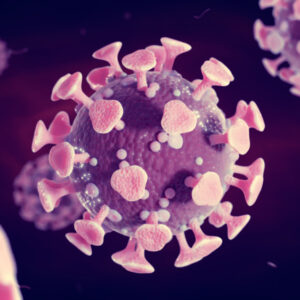Feline Calcivirus
Feline calicivirus (FCV) is one of the most frequently reported pathogens causing upper respiratory tract and oral disease in cats. It is often found in association with other pathogens, forming part of the feline respiratory disease complex. Vaccines are available but high levels of virus population diversity and the increasing virulence of some feline calicivirus strains have ameliorated their effectiveness in some instances.
Feline Calcivirus Background
Feline calcivirus (FCV), a small, unenveloped RNA virus, is one of the most common viral pathogens of cats (Coyne et al., 2006), and is endemic in most catteries, shelters, and large multiple-cat households (Radford et al., 2007). The genome of FCV is ~7.7 kb in length and is an mRNA for open reading frame (ORF) 1. ORF1 encodes an ~1800 amino-acid polyprotein that is cleaved by a viral proteinase into individual polypeptides that produce the viral replication complexes. A sub-genomic mRNA of ~2.4 kb encodes ORF2 and ORF3. ORF2 of FCV encodes the pre-capsid protein (VP1), and ORF3 encodes a minor capsid protein (VP2) (Pesavento et al., 2008).
Feline calicivirus (FCV) was originally isolated from the gastrointestinal tract of cats in New Zealand but is now recognised as a pathogen of the oral cavity and upper respiratory tract. Prevalence rates of between 2% and 40% have been reported in population cross-sectional studies with virus being maintained by long-term carriers or shedders (cats can shed a single isolate for up to 75 days). Most cats do seem to eventually clear infection, and it is thought the majority of ‘carriers’ are undergoing repeated reinfections, with only a minority being truly persistently infected.
Generally, FCV-related disease cause high morbidity and low mortality. However, more virulent systemic forms (VS) of FCV have been identified since the late 1990’s. These differences in the severity of FCV disease are likely related to FCVs high genetic variability, a capacity to persist in infected individuals, stability in the environment, and its ubiquity in feline populations worldwide
Many cats infected with feline calicivirus are persistently infected or infected with FCV isolates that cause mild or not easily detectable disease. Cats showing acute signs of disease usually exhibit fever and lingual or oral ulceration. They may also show upper respiratory signs (e.g., sneezing, rhinitis, conjunctivitis). Epidemiological studies that have identified FCV in natural outbreaks of upper respiratory tract (URT) disease have observed that disease is most likely to be alongside other pathogens. Clinical symptoms associated with different strains of FCV include limping disease, lower respiratory tract disease, and virulent systemic disease (Pesavento et al., 2008).
Live and inactivated vaccines that protect against feline calicivirus are available. Although pre-existing immunity, either from vaccination or previous infection, does reduce clinical signs, it does not induce sterilising immunity. The co-circulation of distinct strains, and lack of sterilising immunity in individual cats, provides an ideal opportunity for mixed infections and genetic recombination, resulting in the continued high prevalence of FCV in the general cat population (Hou et al., 2016).
References
- Coyne et al. (2006). Recombination of Feline calicivirus within an endemically infected cat colony. J Gen Virol. 87 (Pt 4): 921–6.
- Hou et al. (2016). European molecular epidemiology and strain diversity of feline calicivirus. The Veterinary record vol. 178,5: 114-5.
- Pesavento et al. (2008). Molecular Virology of Feline Calicivirus. Vet Clin Small Anim. 38, 775–786.
- Radford et al. (2007). Feline calicivirus. Vet Res. 38(2):319–335.
Feline Calcivirus Antigens
The Native Antigen Company is pleased to provide a native feline calcivirus antigen for all of your assay development and research needs.
Questions?
Check out our FAQ section for answers to the most frequently asked questions about our website and company.

